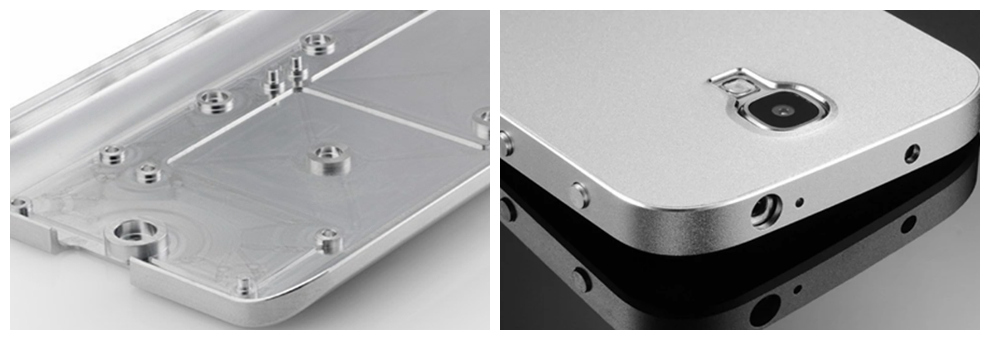Posted on: Nov. 4th, 2020 | By WayKen Rapid Manufacturing
In this era when user experience is highly valued, more and more manufacturers of mobile phones, laptops, and wearable devices are starting to make efforts in housing materials. In the mobile phone field alone, the material of mobile phone housing is also gradually moving from engineering plastic to metal.
Many combinations have emerged during the evolution of mobile phone housing materials, including plastic and metal, glass and metal, all plastic, all-glass, etc., but all metal materials have not been eclipsed in the end. In terms of the actual touch experience, the all-metal mobile phone does have an outstanding experience in many aspects, which is better than other materials in both appearance and hand feeling.
CNC machining is a must for all metal parts. Nowadays, the all-metal housings of mobile phones are almost processed by Numerical control machine tools (CNC). CNC machines have become the necessary equipment for manufactures of mobile phone housing as it has the advantages of high precision, high efficiency, and stable quality.
The mobile phone housing via one-piece CNC machining solution was pioneered by Apple Company at the earliest. They choose aluminum firstly as the iPhone housing due to its advantage of light-weight and easy processing among metals. Unit now, CNC machined Aluminum Frame could still be found in iPhone 12 which Apple has just launched this October. See more details about CNC aluminum machining services here.

3 Major Steps of Aluminum Blocks to Become a Piece of Mobile Phone Housing
There are 3 major processes of aluminum machining from a ponderous block to a piece of precise and aesthetic mobile phone housing. Generally speaking, a rough shape comes out from aluminum die casting; then through aluminum precision machining, the ideal design features gradually appear on the part; and after that, the one-piece précised machined aluminum housing would be given kinds of finishes, like deburring, polishing, sandblasting, color anodizing, etc..
From programming to obtaining finished products, housing manufacturers are necessary to get through rough processing, semi-rough processing, semi-fine finishing, and fine finishing. Generally, the whole process needs 10 stations more to achieve finished products. In order to increase the yield rate, each process ought to be strictly controlled.
Let’s talk more details about the manufacturing processes of mobile housing follows.
Pre-processing CNC: modeling & programming
CNC Modeling and programming is the first step of the CNC machining process. The difficulty in 3D modeling depends on the product structure. Complex product modeling is more difficult and requires more and more complicated programming procedures. Programming is included machining process setting, milling tool selection, milling speed settings, tool feed distance, and so on. What’s more, clamping ways are different for different products. Before processing, it is necessary to design a good fixture and some products with complex structures need to custom a special fixture.
The programming covers all machining processes of the whole product. Though all the aluminum machining is processed automatically by the CNC machine, the early programming must be operated by experienced personnel, which can avoid multiple trials and errors.
Aluminum Machining Processes

- First milling: when the accurate positioning is done, the machine starts roughly milling out the structure of the inner cavity, positioning column with the help of fixture, and the external redundant materials.
- Antenna groove milling: The signal issue of all-metal housing is very tricky. It is important to mill out the antenna groove to set aside the signal transmission path and maintain the structural connection points to ensure the strength and integrity of the body
- Fine CNC milling: finely mill the internal cavity, external structure, external surface, side, etc.
- Polishing: polishing aluminum surface on precisely high-speed CNC machine tools to eliminate the cutting grain. This is for large volume production. At the prototyping stage, aluminum polishing will be processed by handcrafts.
- Sandblasting: sandblasting in fine grits on areas that require anodization.
- Anodization:
a. Primary anodization: anodize aluminum into custom color on aluminum housing. Moreover, it can enhance the stability of the housing surface.
b. Secondary anodization: solid and dense oxide film which is formed on the housing surface, further enhancing wear resistance.
Personal Thoughts
Plastic housings apply the injection molding technology, which has a high yield once the mold is completed. The structural complexity and precision requirements of aluminum machining are the keys to the machining yield rate, so it is difficult to achieve a high yield the same as the plastic housings. For the sake of control the high cost down, most manufacturing enterprises strategically purchase CNC equipment as more as possible to reduce the comprehensive cost and meet the requirements of productivity in the face of the price war.





